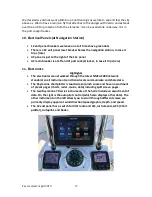
Last revised: April 2019
5
1
–
Emergency Equipment
Highlights
•
3 fire extinguishers
: in the aft cabin, the forward cabin, and on the port side of
the companionway. The engine compartment also has an automatic Halon fire
suppression system.
•
4 inflatable vests
. These are manual inflatable vests. They do not inflate
automatically when wet from rain. We wear these at all times when working the
deck and often in the cockpit and when in the dinghy. There are also
4 blue
conventional vests
in the port cockpit locker in a blue bag.
•
Fog air horn, 4 emergency flares
. In cabinet below top companionway stair.
•
Emergency bilge pump
. Handle clips inside the port cockpit locker. Manual bilge
pump is under the helm seat on the port side.
•
Emergency tiller
. Long curved black pipe in port cockpit locker. Attach under
helm seat after removing round access plate.
•
Lifesling
, starboard stern rail. Please review the diagrams on the face of the case
for procedures. The lanyard is secured to the boat so that tossing the floating
harness allows it to tow behind the boat like a ski tow rope. Circling the person
overboard will draw the recovery line near them.
•
VHF
, Channel 16. VHF at navigation station and the portable.
•
Cockpit cushions
. In case of COB, throw anything that floats, quickly.
Details
Through hulls: All through hulls are located in one place under the floor panel just in
front of the engine compartment. These include the engine raw water intake (with
strainer), the toilet raw water intake, the macerator discharge, the galley sink discharge,
and the head sink discharge. The speed and depth transducers are located under the
floor panels in the forward cabin.




















